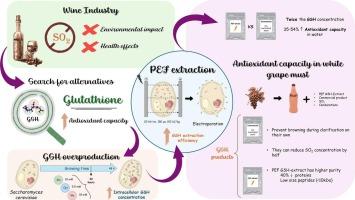从白葡萄酿酒酵母的电穿孔细胞中提取的富含谷胱甘肽的提取物的抗氧化性评价
IF 6.8
1区 农林科学
Q1 FOOD SCIENCE & TECHNOLOGY
Innovative Food Science & Emerging Technologies
Pub Date : 2025-09-25
DOI:10.1016/j.ifset.2025.104258
引用次数: 0
摘要
二氧化硫(SO2)因其抗氧化和抗菌特性被广泛应用于葡萄酒酿造中,但由于健康问题和监管限制,其应用受到越来越多的质疑。谷胱甘肽(GSH)已成为一个有前途的替代品,有效地防止氧化褐变和保存关键的香气化合物。本研究提出了一种结合氨基酸补充和脉冲电场(PEF)技术提高酿酒酵母谷胱甘肽生产和提取的综合方法。添加谷氨酸、半胱氨酸和甘氨酸30 h后,细胞内GSH积累增加53%(产生443±7.9 mg GSH /L培养物)。PEF处理(20 kV/cm, 150 μs, 153.3 kJ/kg)达到90%的膜透性,使细胞内谷胱甘肽的回收率达到66%。冻干提取物中GSH含量为51.2±1.32 mg /g, GSH/GSSG比值为19.2,超过OIV灭活酵母制剂标准。PEF-GSH提取物在水试验中表现出比商业灭活酵母产品更高的抗氧化能力,尽管如此,两者在减轻葡萄must的氧化褐变方面都表现出相当的功效。gsh衍生提取物与SO2的组合使所需亚硫酸盐浓度降低了50%,同时保持了必须的稳定性。此外,PEF-GSH提取物具有较低的高分子量蛋白质含量,降低了浊度风险,提高了其发酵后的适用性。这些发现支持pef辅助提取作为生产富含谷胱甘肽提取物的有效策略,为减少葡萄酒酿造中二氧化硫的使用提供了可行的替代方案。本文章由计算机程序翻译,如有差异,请以英文原文为准。

Antioxidant assessment of a glutathione-rich extract obtained from electroporated cells of Saccharomyces cerevisiae in white grape must
Sulfur dioxide (SO2) is widely used in winemaking for its antioxidant and antimicrobial properties, but its application is increasingly questioned due to health concerns and regulatory restrictions. Glutathione (GSH) has emerged as a promising alternative, effectively preventing oxidative browning and preserving key aroma compounds. This study presents an integrated approach to enhance GSH production and extraction from Saccharomyces cerevisiae, combining amino acid supplementation and Pulsed Electric Fields (PEF) technology. Optimal supplementation with glutamic acid, cysteine, and glycine at 30 h increased intracellular GSH accumulation by 53 % (yielding 443 ± 7.9 mg GSH /L of culture). PEF treatment (20 kV/cm, 150 μs, 153.3 kJ/kg) achieved >90 % membrane permeabilization, allowing the recovery of 66 % of intracellular GSH. The lyophilized extract contained 51.2 ± 1.32 mg GSH/g, with a GSH/GSSG ratio of 19.2, exceeding the OIV standard for inactivated yeast preparations. The PEF-GSH extract exhibited higher antioxidant capacity than a commercial inactivated yeast product in aqueous assays, nonetheless, both showed comparable efficacy in mitigating oxidative browning in grape must. The combination of GSH-derived extracts with SO2 enabled a 50 % reduction in required sulfite concentration while maintaining must stability. Additionally, the PEF-GSH extract exhibited lower high-molecular-weight protein content, minimizing turbidity risk and enhancing its post-fermentation applicability. These findings support PEF-assisted extraction as an efficient strategy for producing GSH-rich extracts, offering a viable alternative to reduce SO2 use in winemaking.
求助全文
通过发布文献求助,成功后即可免费获取论文全文。
去求助
来源期刊
CiteScore
12.00
自引率
6.10%
发文量
259
审稿时长
25 days
期刊介绍:
Innovative Food Science and Emerging Technologies (IFSET) aims to provide the highest quality original contributions and few, mainly upon invitation, reviews on and highly innovative developments in food science and emerging food process technologies. The significance of the results either for the science community or for industrial R&D groups must be specified. Papers submitted must be of highest scientific quality and only those advancing current scientific knowledge and understanding or with technical relevance will be considered.

 求助内容:
求助内容: 应助结果提醒方式:
应助结果提醒方式:


